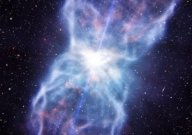Space & Astronomy
November 29, 2012 · 9 comments
9 comments

Image Credit: ESO
"We were hoping to see something like this, but the sheer power of this outflow still took us by surprise," said astronomer Nahum Arav. "I believe this is the smoking gun for several theoretical ideas that use the mechanical energy output of quasars to solve several important problems in the formation of galaxies and cluster of galaxies."
Source: National Geographic | Comments (9)
Most powerful black hole blast discovered
By T.K. RandallNovember 29, 2012 ·
 9 comments
9 comments
Image Credit: ESO
A blast fives time more powerful than anything ever seen before has been found flowing from a black hole.
Located 11.5 billion light years away, the enormous gravity well has a mass equivalent to three billion suns and is situated at the center of an extremely bright and energetic class of galaxy known as a quasar. Astronomers were able to measure the speed of the flow and determine that it was putting out more than 400 times the weight of our sun every year at 18,000 miles per hour."We were hoping to see something like this, but the sheer power of this outflow still took us by surprise," said astronomer Nahum Arav. "I believe this is the smoking gun for several theoretical ideas that use the mechanical energy output of quasars to solve several important problems in the formation of galaxies and cluster of galaxies."
Astronomers have witnessed a record-breaking blast of gas and dust flowing out of a monster black hole more than 11. 5 billion light-years away.
Source: National Geographic | Comments (9)

The Unexplained Mysteries
Book of Weird News
AVAILABLE NOW
Take a walk on the weird side with this compilation of some of the weirdest stories ever to grace the pages of a newspaper.
Click here to learn more

Support us on Patreon
BONUS CONTENTFor less than the cost of a cup of coffee, you can gain access to a wide range of exclusive perks including our popular 'Lost Ghost Stories' series.
Click here to learn more
United States and the Americas
UK and Europe
Other World News
Russia and the War in Ukraine
Total Posts: 7,777,485 Topics: 325,493 Members: 203,902
Not a member yet ? Click here to join - registration is free and only takes a moment!
Not a member yet ? Click here to join - registration is free and only takes a moment!



























Please Login or Register to post a comment.